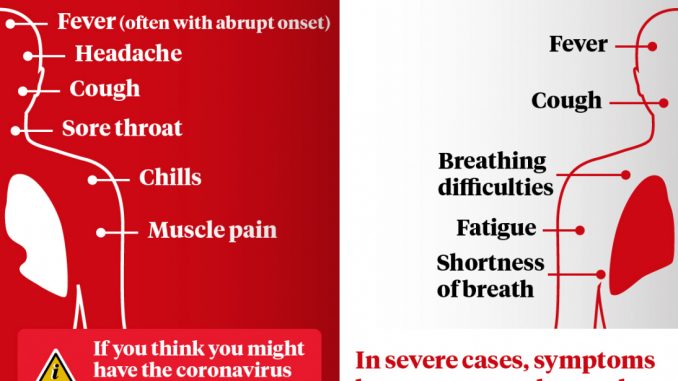
- Coronaviruses are a large family of viruses, some causing illness in people and others that circulate among animals, including camels, cats and bats.
- Coronaviruses are zoonotic viruses i.e. they are transmitted between animals and people.
- Corona virus disease is now commonly known as COVID-19.
Most of us are usually confused with the similarities and differences between COVID-19 and Influenza as these two have similar symptoms and disease presentation as well. So, let us have a look at the similarities and differences between COVID-19 and Influenza as described by World Health Organization (WHO).
Similarities between Influenza and COVID-19:
- Firstly, COVID-19 and influenza viruses have a similar disease presentation. That is, they both cause respiratory disease, which presents as a wide range of illness from asymptomatic or mild through to severe disease and death.
- Secondly, both viruses are transmitted by contact, droplets and fomites. As a result, the same public health measures, such as hand hygiene and good respiratory etiquette (coughing into your elbow or into a tissue and immediately disposing of the tissue), are important actions all can take to prevent infection.
Differences between Influenza and COVID-19:
COVID-19:
- COVID-19 has longer incubation period than influenza.
- It has longer serial interval ranging from 5-6 days.
- The number of secondary infections generated from one infected individual – is understood to be between 2 and 2.5 for COVID-19 virus.
- Usually, children are less affected than adults and that clinical attack rates in the 0-19 age group are low for COVID-19.
- Mortality for COVID-19 appears to be higher than influenza, especially seasonal influenza. As per the data so far, crude mortality ratio (the number of reported deaths divided by the reported cases) is between 3-4%.
- New vaccines have been developed for COVID-19 by different countries. These vaccines have different potency and effectiveness. At the same time, new vaccines are also under trial.
Influenza:
- Shorter median incubation period (time from infection to appearance of symptoms).
- Influenza has shorter serial interval of 3 days.
- The number of secondary infections generated in case of influenza is less compared to COVID-19.
- Children are important drivers of influenza virus transmission in the community.
- For seasonal influenza, mortality is usually well below 0.1%.
- Antivirals and vaccines available for influenza.
| Basis of differences | Influenza | COVID-19 |
| Speed of Transmission | Shorter median incubation period (time from infection to appearance of symptoms) | Longer median incubation period than influenza |
| Serial Interval (the time between successive cases) | Shorter serial interval. The serial interval for influenza is 3 days. | Longer serial interval. The serial interval for COVID-19 virus is estimated to be 5-6 days |
| Speed of Spread | Can spread faster. | Spreads slower than Influenza |
| Time of Transmission | Transmission in the first 3-5 days of illness, or potentially pre-symptomatic transmission –transmission of the virus before the appearance of symptoms – is a major driver of transmission for influenza | We are learning that there are people who can shed COVID-19 virus 24-48 hours prior to symptom onset. But, at present, this does not appear to be a major driver of transmission |
| Reproductive Number | The number of secondary infections generated in case of influenza is less compared to COVID-19. | The number of secondary infections generated from one infected individual – is understood to be between 2 and 2.5 for COVID-19 virus |
| More vulnerable population
|
Children are important drivers of influenza virus transmission in the community. | Initial data indicates that children are less affected than adults and that clinical attack rates in the 0-19 age group are low. |
| Fraction of infection | Fractions of severe and critical infection is less compared to COVID-19. | Fractions of severe and critical infection would be higher than influenza infection. Data to date suggest that 80% of infections are mild or asymptomatic, 15% are severe infection, requiring oxygen and 5% are critical infections, requiring ventilation |
| Who Are At More Risk? | Those most at risk for severe influenza infection are children, pregnant women, elderly, those with underlying chronic medical conditions and those who are immunosuppressed. | As per the current understanding, older age and underlying conditions increase the risk for severe infection of COVID-19. |
| Mortality Ratio | Mortality is less compared to COVID-19. For seasonal influenza, mortality is usually well below 0.1%. | Mortality for COVID-19 appears to be higher than influenza, especially seasonal influenza. As per the data so far, crude mortality ratio (the number of reported deaths divided by the reported cases) is between 3-4%. |
| Availability of Vaccines/Therapeutics | Antivirals and vaccines available for influenza | New vaccines have been developed for COVID-19 by different countries. These vaccines have different potency and effectiveness. At the same time, new vaccines are also under trial. |
News Source: https://www.who.int/news-room/q-a-detail/q-a-similarities-and-differences-covid-19-and-influenza
Date of News Publication: March 17, 2020